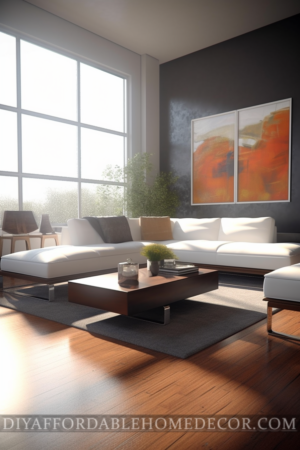 Creating your dream home doesn’t have to be an overwhelming project reserved for professional designers. With a few guiding principles, anyone can transform their living space into a personal haven that reflects their style and meets their needs. This article explores practical steps to simplify interior design, making it accessible and enjoyable for everyone.
Creating your dream home doesn’t have to be an overwhelming project reserved for professional designers. With a few guiding principles, anyone can transform their living space into a personal haven that reflects their style and meets their needs. This article explores practical steps to simplify interior design, making it accessible and enjoyable for everyone.
Understand Your Space
Before diving into design choices, take a moment to understand the space you’re working with. This means considering the room’s size, natural light, and function. A well-understood space is the canvas for your design ideas. Consider these factors:
- Size and Layout: Measure your rooms to get an idea of what furniture will fit and how it can be arranged for flow and functionality.
- Natural Light: Observe how light moves through the space throughout the day. This can influence the color scheme and lighting choices.
- Functionality: Reflect on how you use the room. A living room for relaxation and entertainment might need a different approach than a home office.
Define Your Style
Your personal style is a crucial component of your home design. It’s a reflection of your personality and lifestyle. Start by gathering inspiration from magazines, websites, and social media platforms like Pinterest. Look for common themes in the images you’re drawn to and define your style—be it modern minimalism, cozy country, eclectic, or something else entirely. Remember, the goal is to create a space that feels like you.
Color Schemes Simplified
Color can dramatically affect the mood and feel of a room. To keep it simple:
- Choose a Base Color: Select a neutral shade for walls and large furniture pieces. This provides flexibility and longevity in your design.
- Add Accent Colors: Bring in 2-3 accent colors through accessories like pillows, art, and rugs. These can easily be changed out as your taste evolves.
- Consider the Mood: Different colors can influence the room’s mood. Blues and greens create a calming effect, while yellows and oranges can add energy.
Functional Furniture
Furniture should be both functional and beautiful. When choosing pieces, think about how they will be used and what needs they fulfill. Opt for items that offer storage or serve multiple purposes, especially in smaller spaces. Quality should trump quantity; it’s better to have a few pieces that work well than a room full of furniture that doesn’t serve your needs.
Lighting Layers
Lighting is often overlooked but is crucial to the atmosphere of a room. Aim for layers of light:
- Ambient Lighting: Provides overall illumination of a space and can come from ceiling fixtures or natural light.
- Task Lighting: Focused lights, like desk lamps or under-cabinet kitchen lights, designed for specific tasks.
- Accent Lighting: Adds drama or highlights certain aspects of a room, such as artwork or architectural features.
Personal Touches
What truly makes a house a home are the personal touches. Display items that have meaning to you, whether it’s family photos, heirlooms, or collections. These elements tell your story and add warmth and character to your home.
DIY Projects
DIY projects offer a way to personalize your space while staying on budget. Consider these simple projects:
- Painting: A fresh coat of paint can transform a room. It’s an affordable project with a big impact.
- Reupholstering: Give old furniture a new life with new fabric.
- Upcycling: Turn found objects or old furniture into something new and unique.
FAQs
Q: How do I choose a color scheme for my home? A: Start with a base color that’s neutral and add 2-3 accent colors through accessories. Consider the mood you want to create and use color to enhance it.
Q: What are some budget-friendly design tips? A: Focus on small changes that have a big impact, like paint, new hardware for cabinets, or swapping out light fixtures. DIY projects can also be cost-effective and add a personal touch.
Q: How can I make my small space appear larger? A: Use light colors to make the room feel more open, incorporate mirrors to reflect light, and choose furniture that doesn’t overcrowd the space. Multi-functional furniture can also save space.
Conclusion
Simplifying interior design starts with understanding your space and defining your personal style. From there, smart choices about color, furniture, and lighting can create a cohesive and inviting home. Remember, the most important aspect of your home is that it reflects you and your lifestyle. Embrace the process, and don’t be afraid to put your stamp on your space.
Transforming your home into your dream space is a journey of creativity and personal expression. By following these simple guidelines, you can navigate the world of interior design with confidence and ease. Whether you’re making minor adjustments or embarking on a major redesign, your home can be a reflection of your unique style and a place where you love to spend time.

Recommended Resources for Further Inspiration
If you’re looking for more inspiration, here are some recommended books and resources:
- 70 Best Interior Design Tips From Professional Designers
- Demystifying the Process of Interior Design – STACEY LAPUK INTERIORS
- Style: The Art Of Creating A Beautiful Home – By Natalie Walton
- The Elements of Style – A classic that covers the basics of modern design.
- Homebody – A modern haven of design inspiration.
- The Design of Everyday Things – Focuses on usability in design.
- Sustainable Home – Focuses on eco-friendly design principles.
- The Elements of Style – Covers everything from color palettes to furniture selection.